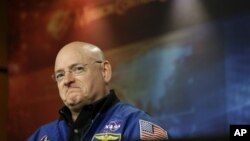Think of where you were and what you were doing six months ago. Now think about where you were and what you were doing 12 months ago.
Veteran NASA astronaut Scott Kelly said that might give you a better idea of what is in store for him and Russian cosmonaut Mikhail Kornienko. They are the two space travelers selected for a one-year stay aboard the International Space Station - more than twice as long as the usual mission.
"People have referred to this as a long-duration ISS mission, and I want to clear something up: that six months is a long-duration mission. Six months is a very long time," Kelly emphasized. "If you think back to what you were doing six months ago, you know, it might be hard for you to remember."
Year in Orbit
The planned 12-month mission will be the longest ever aboard the ISS. This joint U.S.-Russian mission is being developed as the space agencies explore plans for longer manned flights into deep space.
Kelly and Russia's Kornienko are no strangers to space - they each have logged about six months in orbit. The two men have trained together in the past and both say they are looking forward to their partnership.
Russia's space agency has more experience than its U.S. partner with longer duration flights. Four cosmonauts spent a year or more aboard Mir, the Russian space station that was retired in 2001.
Science and the space station
NASA scientist Julie Robinson said researchers know a lot about the ways human beings react during six months in microgravity conditions, when the pull of Earth's gravity is weak and things seem weightless.
Robinson says there is much to be gained from this planned longer mission, adding that the last 12-month Mir mission was in 1999.
"All the lessons of Mir have been incorporated into the International Space Station, and we've even moved on from our sort of International Space Station starting conditions in terms of how we maintain astronaut health and gone to sort of [version] 2.0, if you will, for the exercise hardware, our exercise protocols, our nutrition protocols," said Robinson. "Also, medical technologies have advanced significantly since 1999."
Robinson said one of the goals of this longer mission is to learn whether physiological changes plateau or continue as people spend more time in space.
Bodies in orbit
Scientists have studied the effects of microgravity on muscle mass, strength, vision and bone density. They are hoping to learn more about the effects microgravity has on vein systems in the brain, as some crew members have reported changes to their vision. Researchers also want to figure out how best to train astronauts when there will be a long gap between the time they learn activities and the time they have to carry them out.
Kelly and Kornienko will take a Russian Soyuz spacecraft to the space station in 2015 to begin their year in orbit.
Veteran NASA astronaut Scott Kelly said that might give you a better idea of what is in store for him and Russian cosmonaut Mikhail Kornienko. They are the two space travelers selected for a one-year stay aboard the International Space Station - more than twice as long as the usual mission.
"People have referred to this as a long-duration ISS mission, and I want to clear something up: that six months is a long-duration mission. Six months is a very long time," Kelly emphasized. "If you think back to what you were doing six months ago, you know, it might be hard for you to remember."
Year in Orbit
The planned 12-month mission will be the longest ever aboard the ISS. This joint U.S.-Russian mission is being developed as the space agencies explore plans for longer manned flights into deep space.
Kelly and Russia's Kornienko are no strangers to space - they each have logged about six months in orbit. The two men have trained together in the past and both say they are looking forward to their partnership.
Russia's space agency has more experience than its U.S. partner with longer duration flights. Four cosmonauts spent a year or more aboard Mir, the Russian space station that was retired in 2001.
Science and the space station
NASA scientist Julie Robinson said researchers know a lot about the ways human beings react during six months in microgravity conditions, when the pull of Earth's gravity is weak and things seem weightless.
Robinson says there is much to be gained from this planned longer mission, adding that the last 12-month Mir mission was in 1999.
"All the lessons of Mir have been incorporated into the International Space Station, and we've even moved on from our sort of International Space Station starting conditions in terms of how we maintain astronaut health and gone to sort of [version] 2.0, if you will, for the exercise hardware, our exercise protocols, our nutrition protocols," said Robinson. "Also, medical technologies have advanced significantly since 1999."
Robinson said one of the goals of this longer mission is to learn whether physiological changes plateau or continue as people spend more time in space.
Bodies in orbit
Scientists have studied the effects of microgravity on muscle mass, strength, vision and bone density. They are hoping to learn more about the effects microgravity has on vein systems in the brain, as some crew members have reported changes to their vision. Researchers also want to figure out how best to train astronauts when there will be a long gap between the time they learn activities and the time they have to carry them out.
Kelly and Kornienko will take a Russian Soyuz spacecraft to the space station in 2015 to begin their year in orbit.









